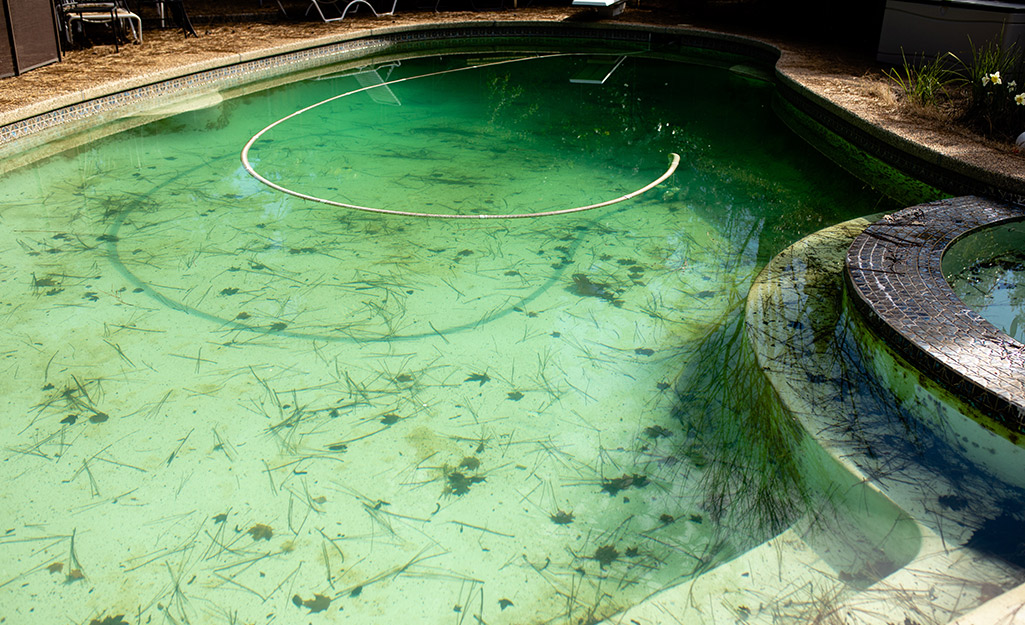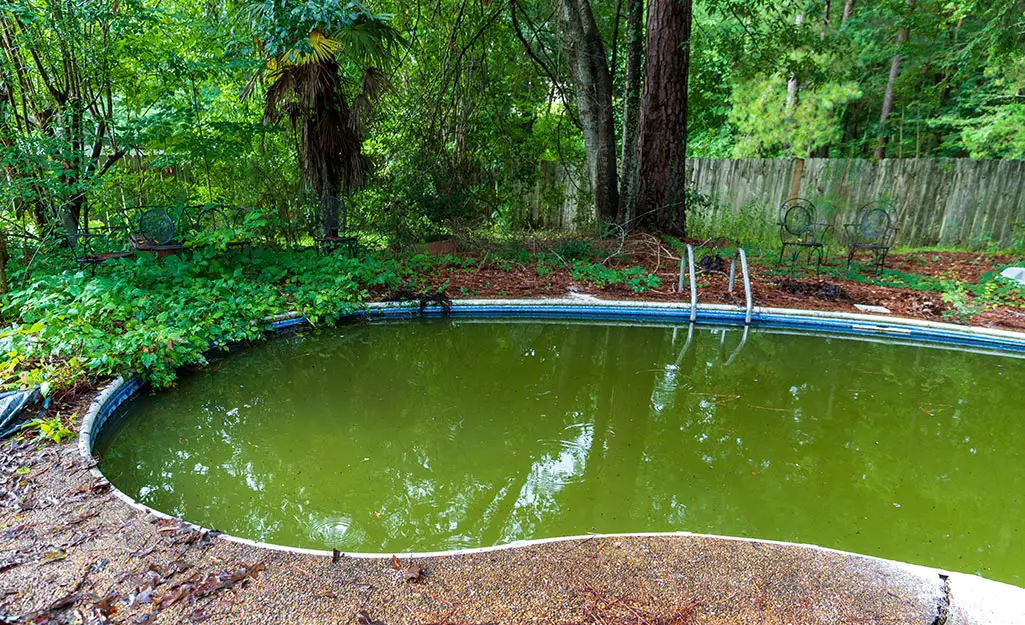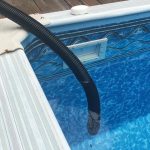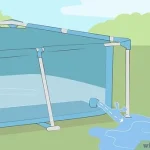To get rid of algae in a pool, it is essential to maintain proper water balance and regularly treat the pool with algaecide. Maintaining a clean and sparkling pool is imperative for a refreshing and enjoyable swimming experience.
However, the appearance of algae can quickly turn your pool into a murky and uninviting mess. Algae growth is a common problem that pool owners encounter, but fortunately, it can be effectively tackled with the right approach. We will explore some practical and straightforward methods to get rid of algae in your pool, ensuring a clear and inviting environment for swimming and relaxation.
By following these steps, you can easily banish algae and regain the pristine beauty of your pool water.
Identifying Algae In Your Pool
Recognizing algae growth is crucial for maintaining a clean and healthy pool. Knowing the signs of algae and understanding the different types can help you take the necessary steps to effectively get rid of it.
Recognizing The Signs Of Algae Growth
Identifying algae growth in your pool can be done by observing the water and pool surfaces for certain signs. These signs may include the presence of green, brown, yellow, or black discoloration in the water or on the pool walls and floor. Additionally, if the water appears cloudy or has a slimy texture, it may indicate the presence of algae.
Different Types Of Algae
Algae comes in various types, each with its distinct characteristics. The most common types found in pools are green algae, which gives the water a green tint, yellow algae, which is often mistaken for dirt or sand, and black algae, known for its stubborn and resistant nature. Understanding the type of algae in your pool is essential for choosing the right treatment method.
Preventive Measures To Avoid Algae
Preventive measures play a crucial role in keeping your pool free from algae. By taking proactive steps to prevent algae growth, you can enjoy crystal-clear water all season long. In this guide, we will discuss essential preventive measures to avoid algae in your pool.
Maintaining Proper Water Circulation
Good water circulation is vital in preventing algae growth. Stagnant water provides a conducive environment for algae to thrive. Ensure that your pool’s pump and filter are operating efficiently to keep the water flowing and prevent stagnant areas where algae can take hold.
Regularly Testing And Balancing Water Chemistry
Regular testing of water chemistry is essential for maintaining a healthy swimming environment. Use a reliable water testing kit to monitor pH levels, chlorine levels, and alkalinity. Balancing these factors will create an environment that is unfavorable for algae growth.
Effective Methods For Removing Algae
Keep your pool algae-free with these effective methods. Discover the best techniques for removing algae and maintaining a clean and sparkling pool.
Every pool owner dreads the sight of algae blooming in their pool water. Effective Methods for Removing Algae are essential to keep your pool clean and inviting. Let’s explore some reliable techniques you can use:Manual Brushing And Vacuuming
Using a pool brush and vacuum to physically scrub and remove algae from pool surfaces helps disrupt its growth.Shock Treatment And Algaecides
Shock treatment raises chlorine levels quickly to kill algae, while algaecides target and eliminate algae in your pool water.Specific Tips For Different Types Of Algae
When it comes to keeping your pool water clean and algae-free, it’s important to understand the specific tips for different types of algae. Each type of algae requires a tailored approach for prevention and removal to ensure a sparkling and inviting pool for you and your family to enjoy. Let’s delve into specific tips for different types of algae, including green algae prevention and treatment, as well as identifying and removing mustard algae.
Green Algae: Prevention And Treatment
Green algae is one of the most common types of algae found in pools, often thriving in warm and stagnant water conditions. To prevent and treat green algae, consider the following tips:
- Regularly test and maintain the pH and chlorine levels in your pool water to create an environment that is inhospitable to algae growth.
- Brush and vacuum the pool walls and floor to remove any algae spores and prevent them from settling and multiplying.
- Shock your pool with a higher dose of chlorine to kill existing algae and prevent further growth.
- Consider using algaecide specifically designed to target and eliminate green algae.
Mustard Algae: Identification And Removal
Mustard algae often presents as a yellow or brownish-green powdery substance on the pool walls and floor. To effectively identify and remove mustard algae, follow these steps:
- Perform a thorough brush and vacuum of the pool to dislodge and remove mustard algae spores.
- Ensure that the pool’s chlorine and pH levels are properly balanced and maintained to inhibit mustard algae growth.
- Use a chlorine-based shock treatment to eliminate existing mustard algae and prevent its recurrence.
- Consider utilizing a specialized algaecide formulated to target and eradicate mustard algae from your pool.
Using Natural Remedies To Combat Algae
Combat algae in your pool naturally with effective remedies. Use eco-friendly solutions like vinegar, baking soda, or a robotic pool cleaner to keep algae at bay. These methods are safe, cost-effective, and promote a healthier swimming environment.
Benefits Of Using Natural Products
Using natural remedies to combat algae in your pool has several benefits. These environmentally friendly solutions are not only effective in eliminating algae, but they also have a positive impact on the overall health of your pool water. Here are some key benefits of using natural products:- Nontoxic: Unlike chemical-based treatments, natural remedies are nontoxic and safe for both humans and pets. This means you can swim in your pool without worrying about any harmful side effects.
- Environmentally Friendly: Using natural products reduces the release of harmful chemicals into the environment. By choosing eco-friendly options, you are making a conscious effort to protect the planet.
- Gentle on Pool Surfaces: Chemical treatments can damage pool surfaces over time. Natural remedies, on the other hand, are gentle and won’t cause any harm to your pool’s walls, floor, or equipment.
- Cost-Effective: Natural remedies are often more affordable compared to commercial chemical treatments. You can find many natural ingredients in your pantry that can effectively combat algae, saving you money in the long run.
- Minimal Maintenance: Natural products require minimal maintenance and can help prevent future algae outbreaks. By incorporating them into your regular pool maintenance routine, you can enjoy a crystal-clear pool all season long.
Diy Solutions For Algae Removal
When it comes to getting rid of algae in your pool, you don’t always have to rely on expensive chemical treatments. There are plenty of DIY solutions using natural ingredients that can effectively combat algae growth. Here are some popular methods you can try:- Vinegar: Mix equal parts of white vinegar and water in a spray bottle. Spray the solution directly onto the affected areas of the pool and scrub with a brush. Vinegar helps kill the algae while also preventing its regrowth.
- Baking Soda: Sprinkle baking soda over the algae-infested areas and brush thoroughly. Baking soda not only kills algae but also helps balance the pH levels in your pool water.
- Hydrogen Peroxide: Dilute hydrogen peroxide with water and pour it onto the algae-affected areas. Allow it to sit for a few hours before scrubbing away the dead algae. Hydrogen peroxide is a powerful oxidizing agent that eliminates algae effectively.
- Black Algaecide: Did you know that black tea can be used to combat black algae in your pool? Brew a strong pot of black tea, allow it to cool, and then pour it directly into the pool. Black tea contains tannic acid, which helps kill black algae.
- Pool Cover Maintenance: Regularly cleaning your pool cover and removing any debris or standing water can prevent algae spores from making their way into the pool. Keeping your pool cover dry and clean is an important step in algae prevention.

Credit: www.homedepot.com
Routine Maintenance Practices
Maintaining routine pool care is essential to prevent algae growth. To remove algae, brush the pool walls and floor, vacuum debris, and shock the water with chlorine. Testing the water regularly helps maintain the proper chemical balance and prevent algae from returning.
Cleaning Pool Filters Regularly
Regular filter cleaning is crucial to prevent algae growth in your pool.
- Turn off the pool pump before starting the cleaning process.
- Remove the filter cartridge or backwash the DE filter for thorough cleaning.
- Rinse the filter thoroughly to remove any debris or algae buildup.
- Check and clean the filter housing to ensure proper filtration.
Scrubbing Pool Walls And Tiles
Scrubbing pool surfaces helps eliminate algae and prevent further growth.
- Use a pool brush to scrub the walls and tiles thoroughly.
- Focus on areas prone to algae, such as corners and steps.
- Consider using a mild algae treatment while scrubbing for enhanced results.
- Regularly inspect and clean pool drains to prevent algae accumulation.
Professional Help And Consultation
When dealing with persistent algae infestations, sometimes seeking professional help and consultation can be the most effective course of action. By enlisting the expertise of pool maintenance services, you can ensure an algae-free environment for your pool, allowing you to enjoy a clean and safe swimming experience.
When To Seek Professional Assistance
If your attempts to get rid of algae in the pool have been unsuccessful, it may be time to consider professional assistance. Certain circumstances, such as recurring algae growth despite regular maintenance efforts, can indicate the need for expert intervention. Additionally, if the pool water has turned green and the algae problem seems out of control, it’s advisable to seek the help of professionals to address the issue.
Finding The Right Pool Maintenance Service
When looking for a pool maintenance service, it’s crucial to find a reputable and experienced provider. Research local companies, read customer reviews, and inquire about the specific methods and products they use to combat algae. Ensure that the service offers comprehensive algae treatment plans and has a track record of effectively resolving similar issues in other pools. Choosing a reliable and skilled pool maintenance service can significantly contribute to the successful eradication of algae from your pool.

Credit: www.youtube.com
Preventing Algae Reoccurrence
Once you have successfully removed algae from your pool, the next step is to prevent its reoccurrence. This requires implementing a regular pool maintenance schedule and educating pool users on algae prevention. By following these steps, you can keep your pool algae-free and maintain its pristine condition.
Implementing A Regular Pool Maintenance Schedule
Maintaining a regular pool maintenance schedule is crucial in preventing algae growth. Here are a few key steps to include in your routine:
- 1. Skimming: Regularly skim the pool’s surface to remove debris, such as leaves and insects, that can contribute to algae growth.
- 2. Brushing: Brush the pool walls and floor to dislodge any algae spores and prevent them from settling and multiplying.
- 3. Vacuuming: Regularly vacuum the pool to remove any remaining dirt and debris.
- 4. Balancing Chemicals: Maintain proper water chemistry by regularly testing and adjusting the pH, alkalinity, and sanitizer levels. Balanced water conditions make it difficult for algae to thrive.
- 5. Filter Maintenance: Clean or backwash the pool filter regularly to ensure it is working efficiently and removing debris that can contribute to algae growth.
- 6. Shock Treatment: Regularly shock the pool with a suitable shock treatment to eliminate any remaining bacteria and algae spores. This helps to effectively kill any potential sources of algae reoccurrence.
Educating Pool Users On Algae Prevention
Aside from regular maintenance, it’s important to educate pool users on the importance of algae prevention. Here are some key points to communicate:
- 1. Shower before swimming: Encourage pool users to shower before entering the pool to remove any body oils, lotions, or cosmetics, which can contribute to algae growth.
- 2. Proper Pool Hygiene: Emphasize the importance of proper pool hygiene, such as avoiding urinating or defecating in the pool, as these bodily fluids can introduce additional nutrients that algae feed on.
- 3. Limit Organic Waste: Encourage pool users to avoid bringing food and drinks into the pool area, as organic waste can provide a food source for algae.
- 4. Regular Water Circulation: Remind pool users to keep the pool water circulating by running the pump and filter system for the recommended duration. Proper circulation helps prevent stagnant areas where algae can thrive.
- 5. Routine Inspections: Encourage pool users to visually inspect the pool regularly and report any signs of algae growth or other maintenance issues. Early detection can help prevent the spread of algae and address other potential problems promptly.
By implementing a regular pool maintenance schedule and educating pool users on algae prevention, you can significantly reduce the chances of algae reoccurrence. Stay proactive, keep an eye out for any signs of algae growth, and enjoy a clean and inviting pool all season long.

Credit: m.youtube.com
Conclusion
Keeping your pool algae-free is vital for a clean and safe swimming environment. By following the tips shared, you can effectively tackle algae growth in your pool. Regular maintenance and proper sanitation are key to preventing algae outbreaks and maintaining crystal-clear water for your enjoyment all summer long.





